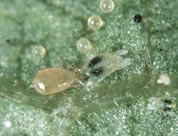By Henry Wainwright
Real IPM

If you asked a rose grower ten years ago what was their greatest pest problem they would immediately say red spider mite. A problem because of the challenge in controlling the pest and the cost, often more than 50% of the crop protection budget would be spent on spider mite control. However there has been a revolution in the strategies used and costs incurred for the control of mites in Kenyan roses. The new technologies involved are broadly three; the use of organosilicon sprays, the use of predatory mites and the application of biopesticides – insect killing fungi.
There are three main types of mites that attack crops in Kenya. Tetranychusurticae that is found on a wide range of crops in Kenya including roses and carnations. Tetranychusevansi whose origin was South America but was introduced into South Africa in the 1980s and is now a major mite of solanaceous crops (e.g. tomatoes and egg plant) in Kenya. Finally there are the group of mites known as broad mites or Tarsonemid mites which are tiny mites, less than 0.3 mm long and virtually impossible to see with the naked eye. These attack crops like strawberries, runner beans and passion fruit. However it is Tetranychusurticae, the red spider mite or two spotted mite that is the bain of the Kenyan rose grower.
Organosilicon spraying
The organosilicon products were originally developed as adjuvants, that is a substance that is mixed with a pesticide to enhance its effectiveness but is not a pesticide in its own right. For instance organosilicons will act as a spreader and enables greater retention of the pesticide on the leaf of the plant. However by increasing the concentration of organosilicons such as Silwet up to around 0.5 %, they could kill the spider mites when used alone. Their mode of action is to disrupt the cuticle of the spider mite causing the mite to dehydrate and die through desiccation. However the effect on mite eggs was minimal so repeated spraying is necessary. The low cost organosilicon wetters were rapidly adopted by growers for mite control as they were cost efficient, effective, had a rapid knockdown, left no residue and were entirely compatible with existing spray techniques. As a consequence conventional miticides were rapidly substituted with organosilicons. However the down side of their use was that plants reacted and closed down their stomata, transpiration was reduced and then growth. A consequence of frequent use in roses was that the stem length reduced and the quality of leaf declined.
Natural enemies
There are a large range of natural enemies of spider mite and many are produced and sold globally. However the star of these is the predator Phytoseiulus persimilis. This is another spider and only predates on spider mite and no other animal. The main advantages of using Phytoseiulus is that it consumes more spider mite than any other predator, reproduces quickly and can seek out the spider mite where they may be hiding in the crop. Once the sider mite has been finished, the predator either starves to death or becomes cannibalistic, the consequence is that the crop is left clean of mites and predators. The disadvantage of Phytoseiulus is that it likes humid conditions to flourish and needs to be re-introduced when the spider mite returns. However this predator is a world beater and is used globally in a huge range of crops from tomatoes, to cucumbers to roses.
The second group of spider mite predators are Amblyseius species, A.californicus and A.andersoni. These work as generalists as they can consume not only spider mite but other prey and even fungi and pollen on occasions to remain alive. Their combination with Phytoseiulus offer a good back-up as they are always present in the background. However they are not as efficient as Phytoseiulus and cannot cope with large populations or spider mite hot spots in a crop. A.calcifornicus seems to be suited to the warmer and drier climates whilst A.andersoni likes the slight higher altitude cooler conditions. The main adva ntages of using predators are that the crop is cleaner as the predators seek out the pest, they eat all like stages of mites from eggs through to adults, the crop quality is improved as spraying harsh chemicals is reduced and


